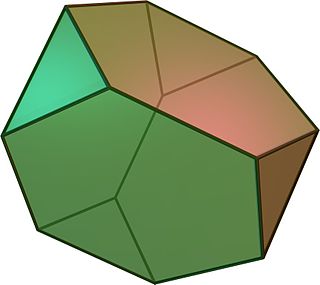
Back Триангулиран пресечен тетраедър Bulgarian Tetràedre truncat Catalan Tetraederstumpf German Κόλουρο τετράεδρο Greek Senpintigita kvaredro Esperanto Tetraedro truncado Spanish Tetraedro moztu Basque چهاروجهی بریدهشده Persian Tétraèdre tronqué French ארבעון קטום HE
| Truncated tetrahedron | |
|---|---|
 (Click here for rotating model) | |
| Type | Archimedean solid Uniform polyhedron |
| Elements | F = 8, E = 18, V = 12 (χ = 2) |
| Faces by sides | 4{3}+4{6} |
| Conway notation | tT |
| Schläfli symbols | t{3,3} = h2{4,3} |
| t0,1{3,3} | |
| Wythoff symbol | 2 3 | 3 |
| Coxeter diagram | |
| Symmetry group | Td, A3, [3,3], (*332), order 24 |
| Rotation group | T, [3,3]+, (332), order 12 |
| Dihedral angle | 3-6: 109°28′16″ 6-6: 70°31′44″ |
| References | U02, C16, W6 |
| Properties | Semiregular convex |
 Colored faces |
 3.6.6 (Vertex figure) |
 Triakis tetrahedron (dual polyhedron) |
 Net |

In geometry, the truncated tetrahedron is an Archimedean solid. It has 4 regular hexagonal faces, 4 equilateral triangle faces, 12 vertices and 18 edges (of two types). It can be constructed by truncating all 4 vertices of a regular tetrahedron at one third of the original edge length.
A deeper truncation, removing a tetrahedron of half the original edge length from each vertex, is called rectification. The rectification of a tetrahedron produces an octahedron.[1]
A truncated tetrahedron is the Goldberg polyhedron GIII(1,1), containing triangular and hexagonal faces.
A truncated tetrahedron can be called a cantic cube, with Coxeter diagram, ![]()
![]()
![]()
![]()
![]() , having half of the vertices of the cantellated cube (rhombicuboctahedron),
, having half of the vertices of the cantellated cube (rhombicuboctahedron), ![]()
![]()
![]()
![]()
![]() . There are two dual positions of this construction, and combining them creates the uniform compound of two truncated tetrahedra.
. There are two dual positions of this construction, and combining them creates the uniform compound of two truncated tetrahedra.
- ^ Chisholm, Matt; Avnet, Jeremy (1997). "Truncated Trickery: Truncatering". theory.org. Retrieved 2013-09-02.